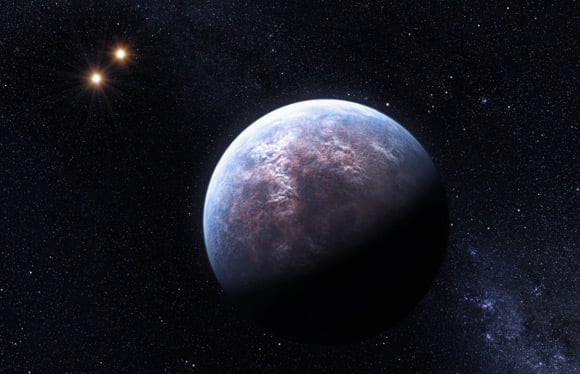This article is more than 1 year old
Astronomers spy 32 new exoplanets
Galaxy packed with 'super-Earths'
The European Southern Observatory (ESO) has announced its discovery of 32 new exoplanets - a bountiful harvest of new worlds to conclude the initial five-year phase of its High Accuracy Radial Velocity Planet Searcher (HARPS) planet-sniffing programme.
The 32 bodies range in size from five times the mass of Earth to 5-10 times the mass of Jupiter. HARPS detects "small changes in the radial velocity of a star as it wobbles slightly under the gentle gravitational pull from an (unseen) exoplanet", and its accuracy has enabled it to sniff out "24 of the 28 planets known with masses below 20 Earth masses".

Among the latest crop of such bodies is a "super-Earth" orbiting Gliese 667 C, which weighs in at six Earth masses (see artist's impression, above). The ESO explains that it "circulates around its low-mass host star at a distance equal to only 1/20th of the Earth-Sun distance", and that "the host star is a companion to two other low-mass stars, which are seen here in the distance".
The total of known exoplanets now stands at around 400. The HARPS observations, made using the ESO 3.6-metre telescope at La Silla, Chile, have concentrated on "solar-like stars, low-mass "M dwarf" stars, or stars with a lower metal content than the Sun".
Its previous sightings include the first super-Earth, spotted orbiting around µ Ara in 2004, and the "first super-Earth in the habitable zone of a small star".
The HARPS team's findings over five years suggest that our galaxy is peppered with these "low-mass" bodies. Stephane Udry from Geneva University explained to the BBC: "From [our] results, we know now that at least 40 per cent of solar-type stars have low-mass planets. This is really important because it means that low-mass planets are everywhere, basically."
Another significant result of the HARPS survey is that the ESO has identified "three candidate exoplanets around stars that are metal-deficient". It elaborates that such stars "are thought to be less favourable for the formation of planets, which form in the metal-rich disc around the young star", but that "planets up to several Jupiter masses have been found orbiting metal-deficient stars, setting an important constraint for planet formation models".
The ESO will now continue search for super-Earths around solar-type stars and M dwarfs, and hints that new exoplanetary announcements are imminent, based on the last five years' observations.
There's more on the new discoveries here. ®
